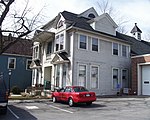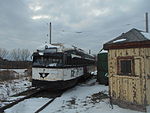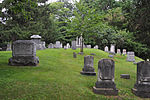Rochester Street Historic District
Historic districts in Monroe County, New YorkHistoric districts on the National Register of Historic Places in New York (state)Monroe County, New York Registered Historic Place stubsNRHP infobox with nocatNational Register of Historic Places in Monroe County, New York ... and 1 more
Use mdy dates from August 2023

Rochester Street Historic District is a national historic district located at Scottsville in Monroe County, New York. The district encompasses 41 residential structures, over half of which date from the 1830s through 1850s and are distinct examples of Greek Revival architecture.It was listed on the National Register of Historic Places in 1973.
Excerpt from the Wikipedia article Rochester Street Historic District (License: CC BY-SA 3.0, Authors, Images).Rochester Street Historic District
Rochester Street, Town of Wheatland
Geographical coordinates (GPS) Address Nearby Places Show on map
Geographical coordinates (GPS)
| Latitude | Longitude |
|---|---|
| N 43.023611111111 ° | E -77.746944444444 ° |
Address
Rochester Street 38
14546 Town of Wheatland
New York, United States
Open on Google Maps











